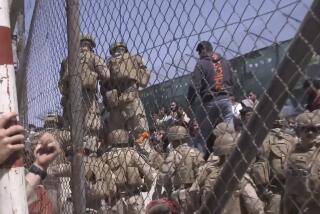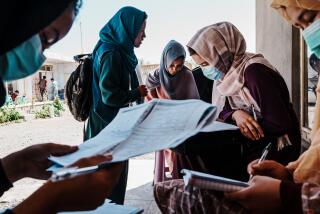U.S. Escalates Its Air War on Taliban North of Kabul
- Share via
RABAT, Afghanistan — U.S. warplanes, including at least one B-52, poured down scores of bombs on Taliban forces along the front lines north of Kabul on Wednesday, shaking a strategic ridge that overlooks the opposition’s best route to the Afghan capital.
The highflying B-52 Stratofortress dropped about 30 bombs in each of two midday strikes on Taliban forces near the main road to Kabul and on Tota Khan ridge, a hilltop Taliban outpost that has been a target of almost daily airstrikes for nearly two weeks.
On top of the B-52 strikes, U.S. F/A-18 fighters dropped more than 25 other bombs on suspected tank, antiaircraft and other Taliban positions here during five hours of intense airstrikes.
U.S. warplanes also struck a wide range of targets elsewhere in Afghanistan on Wednesday, including the strategic northern city of Mazar-i-Sharif, where the anti-Taliban forces are locked in battle against the radical Islamic regime. And they struck targets in the southern city of Kandahar, the cultural and spiritual center of the Taliban.
The use of the B-52 for so-called area bombing here on the front north of Kabul indicates an intensification of the U.S. effort against the Taliban field forces, and the kind of fierce tactics that hawkish analysts in the United States have been urging for weeks.
Wednesday’s bombing suggests that the U.S. strategy is to smooth the way for a threatened ground offensive toward Kabul by opposition Northern Alliance forces, which some commanders have hinted that the alliance may launch within days.
Pentagon officials said Wednesday that the strikes have set the stage not only for the Northern Alliance to launch its drive but also for the United States to send additional ground forces into the embattled country after the snow melts in the spring.
Under this scenario, the opposition forces--with U.S. help--would move to open the road linking Kabul to Uzbekistan, which neighbors Afghanistan to the north. In an upcoming trip through the region, Defense Secretary Donald H. Rumsfeld is expected to seek permission to launch aircraft, armor and soldiers from several countries bordering Afghanistan.
Rumsfeld is slated to meet with leaders of Uzbekistan, Tajikistan and Pakistan over the next several days, with U.S. use of airfields and military bases expected to be high on his agenda.
At a Pentagon briefing, Rear Adm. John D. Stufflebeem, a senior official with the Joint Chiefs of Staff, responded cautiously to questions about the B-52 bombing raids Wednesday, saying he couldn’t discuss tactics in such detail.
But he said that B-52s “are being utilized all over the country, including on Taliban forces in the north.”
He acknowledged that the Pentagon had shifted the focus of the air campaign so that more of the effort was now directed at providing air support for the anti-Taliban forces.
Although the bombing Wednesday appeared to fit the description of “carpet bombing,” the military prefers to describe such attacks as “area bombing.” The former term gained a negative connotation during the Vietnam War as an indiscriminate and imprecise style of attack.
Even as the air war escalated Wednesday, Taliban vehicles were seen driving in and out of the bombing zone north of Kabul, and their forces fired rockets into Northern Alliance territory from an area that had been heavily bombed only minutes earlier.
“They didn’t hit the targets exactly,” the local alliance commander, Halozai Ahmed Ali, said as he watched the bombs explode about 2 1/2 miles away. “Three bombs missed, but two bombs were pretty close to the Taliban’s camps.”
The commander added that while Wednesday “was better than other days, it’s not clear to me how many Taliban have been killed. They change their positions each time.”
Heavy Strikes Welcomed
At least two tanks in the area that were bombed late Wednesday afternoon near the village of Aster Gache were still there at sunset. But the U.S. jets appeared to have hit a third and set it on fire, the commander said.
Yet after weeks of complaints from the Northern Alliance that the U.S. airstrikes on the Kabul front were too weak and infrequent, Ali said the B-52 strikes, followed by wave after wave of bombing runs, were a welcome change.
“If they continue for a week or more like this, it’s possible the Taliban will be defeated on this front,” he said cautiously.
Opposition commanders met again Wednesday morning to discuss a possible ground attack to break through Taliban lines and try to surround Kabul. But even as the Northern Alliance troops were put on higher alert, their leaders appeared to be waiting for U.S. air power to crush Taliban resistance before even testing their enemy with a concerted attack.
“Both of us need heavy bombing on Taliban targets, because the U.S. must finish its fighting, its duty, early,” said Gen. Abdul Basir, a senior alliance commander. “Otherwise, the Afghan people will think America has been defeated in Afghanistan and then they [Afghans] must be careful in their attacks.”
B-52s can carry cruise missiles, cluster bombs that drop smaller “bomblets” over a wide area, or larger satellite-guided bombs that are pre-programmed with the target’s precise coordinates.
The use of the B-52 Wednesday may signify that the Taliban forces are, in some areas, moving into more concentrated positions for offensive action. U.S. defense officials in Washington have been arguing that there was little need for area bombing because the Taliban troops were so widely dispersed.
In the 1991 Persian Gulf War, B-52s were used to undermine the morale of Iraqi President Saddam Hussein’s elite Republican Guard troops. The B-52 dropped 40% of all the bombs used in the Gulf War.
The B-52 that struck the Taliban’s front lines at noon Wednesday flew in from the north, as high as a passenger airliner, trailing four white jet streams. Several miles before it reached the target area, the bomber dropped its payload.
The first strike was aimed at Taliban positions near the village of Karabakh that command the main road south into Kabul. The opposition hopes the road will provide a quick route to the capital for its tanks and armored vehicles if the Taliban forces can be driven out.
After banking hard to the right over Kabul, the B-52 disappeared to the north only to return 15 minutes later on much the same flight path as the first bombing run, too high for Taliban antiaircraft fire to be a threat.
The bombs could be seen through a photographer’s zoom lens falling in pairs, striking Tota Khan ridge about 30 seconds later. They exploded in a long ribbon of bright orange blasts that rumbled like thunder and sent plumes of black smoke and dust into the air.
About 25 minutes after the second B-52 strike, a car or small truck speeded off from Tota Khan toward Kabul, leaving a long trail of brown dust. It got away unscathed, and when the F/A-18 Hornets returned soon after, the Taliban fired a single mortar bomb that exploded a couple of hundred yards from commander Ali’s rooftop observation post.
Wave after wave of fighters bombed Tota Khan and other front-line targets for two more hours before a truck was spotted heading back toward the ridge from the direction of Kabul, perhaps to pick up wounded.
But the vehicle didn’t leave before darkness, and opposition commanders say the Taliban trucks come down the mountain slope into the Tota Khan area each night, with their lights on, and U.S. warplanes don’t attack them.
Taliban ‘Degraded’
Although the bombing campaign has been dismissed in some quarters as doing more harm than good because it has unified the enemy in a primitive country that has few worthwhile military targets, the Pentagon insists that the strikes have virtually crippled the ability of the Taliban to coordinate its movements or keep itself supplied with food and ammunition.
“The centralized command and control” of Taliban forces “has been severely degraded” by the bombing, Stufflebeem said. It is now “extremely difficult for them to communicate with one another.”
Although the Pentagon has drafted a number of plans for sending American troops into Afghanistan, knowledgeable sources said there isn’t enough time to implement them before heavy snows blanket much of the country. Troops have to be chosen for this new kind of warfare, equipped and trained. These elaborate preparations will be impossible to hide for any length of time, Pentagon officials acknowledged.
The recent, quick-hit raid by Army Rangers on a former Soviet airfield near Kandahar is the kind of operation that will precede any sizable commitment of troops, knowledgeable military officers said. They theorized that the main purpose of that raid was not to capture enemy documents but to determine whether the airfield could accommodate C-130 transport planes filled with U.S. troops.
A recently retired general who planned combat operations for mountainous places such as Afghanistan predicted Wednesday that U.S. ground operations would feature quick in-and-out strikes. He said his former colleagues commanding the Army learned from the Russians’ experience in the country in the 1980s and won’t try to occupy Afghanistan for any length of time.
“They went in too heavy with a mechanized force,” the general said of the Russians. “They got bogged down. We’re not going to do that.
“I’d go in with a battalion with beefed-up artillery,” he said, “and stay no more than five to 13 days. Take the troops in by choppers or, if you have the landing field, by C-130s. Keep hitting them. Do 30 raids, one after the other--some by just a platoon, others by a battalion. If you get good intelligence that there is a concentration of enemy troops or armor somewhere that you can get close to by air, fly in just artillery units. Fire away for four hours and then leave. At some point, go in with a brigade of 3,000 men.”
The general said he had no inside knowledge of what outfits would be tapped to fight in Afghanistan but said that the 101st Airborne Division “would be ideal.” A small part of the 10th Mountain Division, reportedly about 1,000 troops, is already in Uzbekistan, according to military sources. But their job is said to be mostly to protect U.S. helicopter rescue forces.
*
Watson reported from Rabat and Richter and Wilson from Washington.
More to Read
Sign up for Essential California
The most important California stories and recommendations in your inbox every morning.
You may occasionally receive promotional content from the Los Angeles Times.













